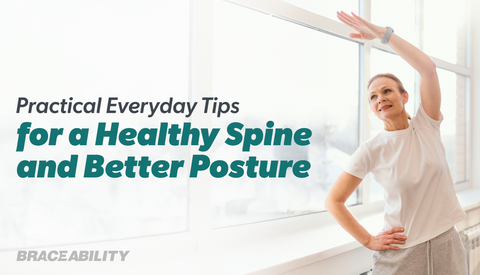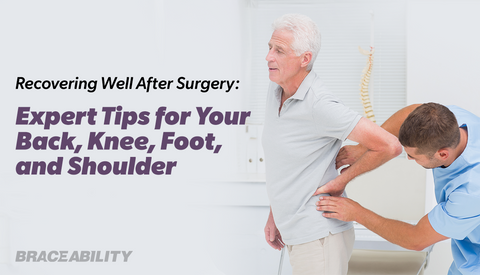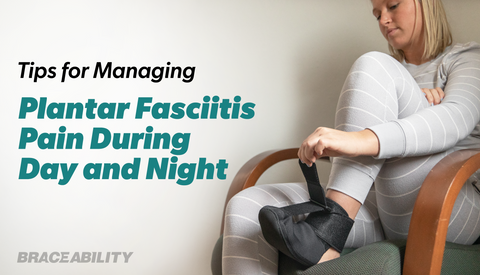Upper Back Pain
Upper back pain is something almost everyone will experience in their lifetime. Pain in the thoracic region (upper back) comes in a variety of shapes and sizes, often making it hard to diagnose what the pain is, and where it is coming from. Pain in your upper back can vary from acute pain to a cervical spine condition. Because of this, we created an upper back guide to help you identify which type of pain you are suffering from. Is it your right upper back? Pain in between your shoulder blades? Or maybe you’re experiencing pain that radiates all over your back. Start by locating the trigger point of your back pain with the graphics below. Once you have found it, read more about the potential conditions in this area, what is likely causing the pain, and how you can best treat it!
4 Main Causes of Upper Back & Neck Pain

If you’re experiencing pain in the area highlighted above, your pain is located within your cervical spine. The anatomy of your cervical spine consists of bones, ligaments, nerves, muscles, and tendons. Neck pain is very common and can be caused by a wide variety of reasons. While neck pain can be acute and not serious, other neck conditions may leave a person struggling to make it through the day. Read more below to find which upper back or neck pain condition you’re most likely experiencing and why.
-
Cervical Radiculopathy
“My pain originates at my neck but radiates in between my shoulder blades. The pain and stiffness is at its worst first thing in the morning and improves as I begin moving around. When I’m lying down and resting I have the most relief.”
Symptoms of Cervical Radiculopathy
The main symptom of cervical radiculopathy is the unique pain that is likely to spread into your arm, neck, upper back, check, and shoulders. Often, this pain will only affect one side of your body. If you are dealing with radiculopathy you may also experience numbness or tingling in your fingers/hands, or muscle weakness, lack of coordination, and loss of reflexes in your arms or legs.
Cervical Radiculopathy Causes
Cervical radiculopathy, also known as a “pinched nerve”. This happens when the neck is compressed or irritated at the point where it branches from the spinal cord. In older individuals, this injury stems mostly from aging. However, younger people who experience a pinched nerve most likely had a herniated disc prior.
Cervical Radiculopathy Treatment
Thankfully, this condition most often has an expiration date. To ensure it’s treated, many people use conservative methods while they are healing. The most popular methods include bracing, medication, and physical therapy. However, for those of you whose condition isn’t improving, consulting with a doctor is vital to ensure you are healthy again. In severe cases, surgery can be an option.
-
Simple Muscle Strain or Sprain
“My pain originates at my neck but radiates down through my shoulders, arms, and even hands. The pain is almost like a sharp burning sensation.”
Symptoms of Muscle Strains and Sprains
The most common muscle strains or sprains symptoms include pain, tenderness, and weakness in the muscle. Depending on the severity of the strain you may also experience redness, bruising, swelling, and limited range of motion.
Muscle Strain or Sprain Causes
Simple muscle strains or sprains are the most common forms of neck injuries. These injuries usually last no longer than a couple of weeks. These strains are usually caused by overuse or overextension of the cervical spine. The most common causes of simple neck muscle strains or sprains is poor posture, sports injury, repetitive motion, sleeping in the wrong position, and whiplash.
Treatment for Muscle Sprains & Strains
Protecting the strained muscle as it heals is the most important part of the recovery in this circumstance. Muscle sprain because of poor posture can be corrected with a variety of posture correcting braces. If you have a more severe issue with your neck and cervical spine consider more intense bracing, like this cervical collar brace. Intense braces are great options to protect and heal your neck, you can also consider icing the painful area to help alleviate the problem.
-
Cervical Osteoarthritis
“My neck is in a lot of pain and feels stiff. I notice the pain when I’m upright and moving my head. I have episodes where the pain gets much more severe and is even felt in my lower back.”
Symptoms of Cervical Osteoarthritis
The symptoms and signs of cervical osteoarthritis or spondylosis include neck stiffness and pain, headaches, pain in the arms and shoulders, inability to fully turn the head or bend the neck, and grinding noise or sensation when the neck is turned.
Causes of Cervical Osteoarthritis
With age, normal wear and tear of bones, discs, and joints of the neck will occur. The discs of the cervical spine gradually break down, lose fluid and become stiffer with time.
Cervical Osteoarthritis Treatment
Primary treatment includes rest, physical therapy, weight loss, and anti-inflammatory medication. Wearing an osteoarthritis support brace is a great way to recover while continuing with daily activities.
-
Cervical Degenerative Disc Disease
Cervical Degenerative Disc Disease Symptoms
When it comes to pain flare-ups associated with cervical degenerative disc disease, episodes can last between a few days to several weeks. You’re likely to experience continuous pain around the degenerating disc, a “giving out” sensation in the neck or back, increased pain with bending or twisting, and muscle tension or spasms.
Causes of Degenerative Disc Disease
Degeneration of the disc is a natural process of aging. When aging occurs more rapidly or prematurely it is considered “degeneration”. This process reduces the flexibility of the disc and often the height of the disc.
Degenerative Disc Disease Treatments
There are many forms of treatment outside of surgery for those suffering from cervical degenerative disc disease. You must avoid painful positions and protect your neck with a brace, like this one. To manage the pain, anti-inflammatory medication is helpful, along with steroid pills. If none of these options are not helping your pain, consulting with your doctor about surgery may be your best option.
Top 4 Causes of Pain Between Shoulder Blades

If you’re experiencing pain in between your shoulder blades you should not ignore it. Unfortunately, pain in the shoulder blades can be a variety of things, making it hard to diagnose. Shoulder blade pain can range from bad posture to a serious illness. Read the bolded descriptions below to find which neck pain you’re most likely experiencing and why.
-
Mild Muscle Irritation
Mild Muscle Irritation Symptoms
While the symptoms and severity of muscle irritation will vary, the most common symptoms you will experience include soreness and aching in the muscles including tension, stress, and localized pain.
Causes of Mild Muscle Irritability
Most often, muscle irritation occurs from some level of discomfort to any given area. You’re most likely to experience this if you are working a sedentary job or performing an activity your body isn't used to.
Muscle Irritation Treatment
Because muscle irritation between the shoulder blades stems from bad posture, posture correction is the best solution. Wearing a posture brace will help to ensure that your muscle memory is correcting its natural stance. Correcting the natural stance will relieve the pain you’ve been experiencing. Check out BraceAbility’s line of posture correctors.
-
Gallbladder Disease
Main Symptoms of Gallbladder Disease
If you’re experiencing pain between your shoulder blades that restricts movement in your back, which is especially stiff in the morning, you may be experiencing gallbladder disease. The most common symptom of this disease is pain in the mid to upper-right section of your abdomen, although you may also experience nausea, fever, chills, or jaundice.
Gallbladder Disease Causes
Gallbladder disease is caused most often in two different ways. Either gallstones form, or the gallbladder is inflamed. Gallbladder disease is known for causing lots of referred pain (pain that exists outside of the trigger point) and can be extremely weakening for a person.
Treatment Options for Gallbladder Disease
If you think you may have gallbladder disease you should consult with a doctor. Most often people will initially be prescribed antibiotics. Your doctor may also recommend surgery to remove the gallstones or gallbladder depending on severity.
-
Thoracic Facet Joint Strain
“I’m experiencing a variety of pain in my upper body that feels unusual. I have episodes of chest pain, shortness of breath, back pain between my shoulders, unusual fatigue, and lightheadedness. These symptoms usually occur after I’ve performed a physical activity like exercise, or even after just walking up a flight of stairs.”
Signs & Symptoms of Thoracic Facet Joint Strain
Thoracic facet joint syndrome can cause pain in your back to the point where you may find yourself having a restricted range of motion. When this occurs, you will notice the need to turn your entire body in order to look over to the right or left. Other common symptoms you may experience include referred pain, tenderness, stiffness, and an overall effect on posture and activity.
Thoracic Facet Joint Strain Causes
Thoracic facet joint strain occurs when the small joints between the vertebrae (facet joints), are overloaded or overworked. This is most often a result of poor posture or sudden movement of the joint. The facet joints inflame, causing the muscles on either side of the spine to go into a spasm.
Treatment for Thoracic Facet Joint Strain
Treatment methods for thoracic facet joint strain are usually conservative. Resting and avoiding whatever is causing the strain will provide you with the best results. Many people recommend using a hot pack a few times throughout the day to reduce the pain.
-
Warnings of a Heart Attack
Signs and Symptoms of a Heart Attack
Symptoms of a heart attack come in a variety of different shapes and sizes. Beyond the extreme chest pain, you may experience shortness of breath, back pain, jaw locking, fatigue, and a sense of uneasiness or knowing something is off. These rare symptoms are much more common for women and should be taken very seriously.
Heart Attack Causes
A heart attack occurs when one or more of your coronary arteries becomes blocked. Certain risk factors contribute to a heart attack occurring including aging, tobacco use, high blood pressure, obesity, stress, family history of heart attacks, and diabetes.
Treatment for Heart Attack Warnings
If you or someone you know is experiencing the warning signs of a looming heart attack take them to the hospital immediately. Because these symptoms are not often recognized as heart attacks they are commonly overlooked and in return may be fatal.
What is Causing My Upper Right or Left Back Pain?

Similar to pain elsewhere in the back, upper right or left back pain has a wide range of severity. Most commonly it stems from poor posture. However, targeted one-sided back pain often has connections with more serious issues.
-
Poor Posture and Muscular Pain
“I’m feeling severe pain under my right ribs and my right upper back. Sometimes I’m even nauseated, vomiting, or have a loss of appetite.”
Symptoms of Poor Posture and Muscular Pain
The symptoms and signs of poor posture can range based on how bad your posture is. Common symptoms include rounded shoulders, body aches and pains, muscle fatigue, headaches, and upper back pain.
Poor Posture Causes
Poor posture is extremely common, but also extremely overlooked. People complain about back issues but never correct the true cause of the problem- bad posture. When you are working a sedentary job and holding poor posture you are bound to experience back issues. People who rely heavily on one side (because they are right or left-handed), will likely begin having targeted one-sided pain in that area.
Treatment for Poor Posture and Muscular Pain
Start working towards correcting your posture immediately! Wearing a posture brace is a great way to change the muscle memory of your upper back. Along with this, perform posture correcting exercises and stretches to begin working towards a pain-free posture position.
-
Gastrointestinal Disorder Condition
Signs & Symptoms of Gastrointestinal Disorder Conditions
If you are experiencing targeted pain in your shoulder, causing your range of motion to be limited and stiffen up, you may likely be dealing with a gastrointestinal disorder condition. Gastrointestinal disorders most often cause pain in the abdomen and generalized stomach area. You may also experience abdominal discomfort, nausea, acid reflux, and fatigue.
Gastrointestinal Disorder Condition Causes
The formation of gallstones can cause the gallbladder to inflame, this pain is often related directly to gastrointestinal conditions. Common causes of gastrointestinal problems include a low fiber diet, stress, not drinking enough water, an inactive lifestyle, aging, and genetic factors.
Treatment Options for Gastrointestinal Disorders
If you have any concerns with your gallbladder, it is best to consult your doctor immediately. There are a variety of different gastrointestinal treatment options your doctor may recommend.
-
Frozen Shoulder (Adhesive Capsulitis)
“I go through a variety of different pain levels in my shoulders. Sometimes the pain goes mostly unnoticed. Then, I’ll go through a period of time where the pain is extremely severe and it hurts to even lift my arms and I won’t be able to fall asleep.”
Frozen Shoulder Symptoms
Adhesive capsulitis, better known as frozen shoulder, is a condition known for the stiffness and pain that occurs in your shoulder joint. The main symptoms of a frozen shoulder are the pain and stiffness that make it either difficult or completely impossible to move your shoulder.
Causes of Frozen Shoulder
There are a variety of different reasons you may be experiencing a condition known as frozen shoulder. For example, hormonal imbalances, diabetes, or weakened immune systems all make a person more likely to have joint inflammation. It’s most common in adults ages 40-60 and is often felt after a long period of inactivity from injury, illness, or post-surgery.
Adhesive Capsulitis Treatment Options
Frozen shoulder can be left untreated, but it has the potential to last up to three years. The most commonly recommended forms of treatment are physical therapy, medication, ice and heat treatments, a shoulder wrap, and potentially surgical options. If you believe you or someone you know may have a frozen shoulder consult with a doctor.
-
Calcific Shoulder Tendonitis
Symptoms of Shoulder Tendonitis
The most common signs and symptoms of calcific shoulder tendonitis include a sudden onset of pain, loss of shoulder range of motion, loss of muscle mass, intense pain and stiffness with shoulder movement, and tenderness over the rotator cuff.
Calcific Shoulder Tendonitis Causes
The cause of calcific tendonitis is somewhat of a mystery. Some doctors claim wear and tear, others say it’s purely old age, it may even be because of a lack of oxygen in the tendons.
Treatments for Shoulder Tendonitis
Thankfully, calcific shoulder tendonitis has some conservative treatment options. Most often it’s recommended to rest your shoulders as much as possible. Any type of anti-inflammatory medication is highly recommended to cope with the pain you may be feeling. Beyond conservative methods, doctors have some surgical options to help with more severe cases.













